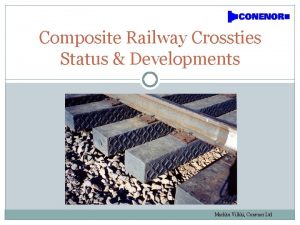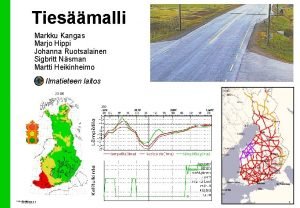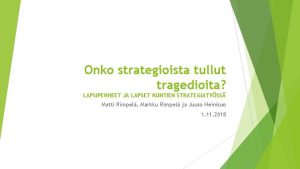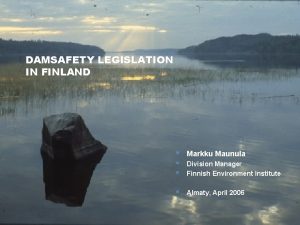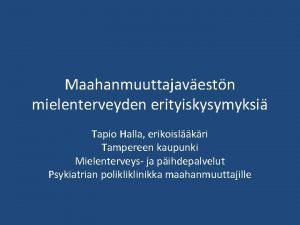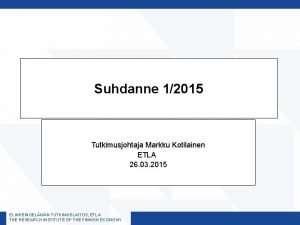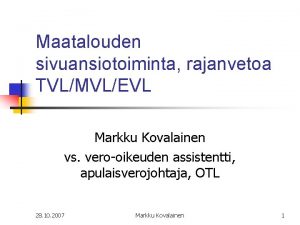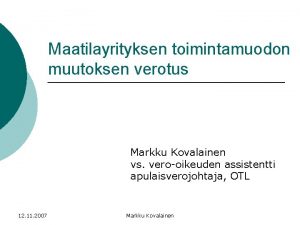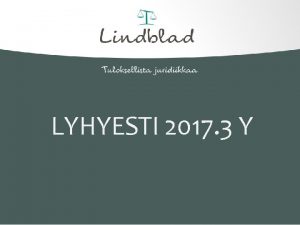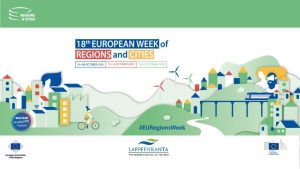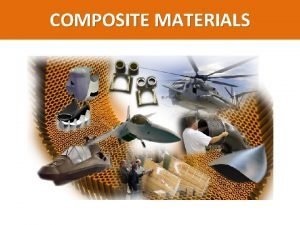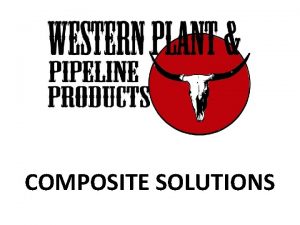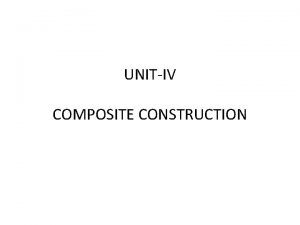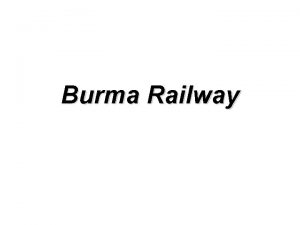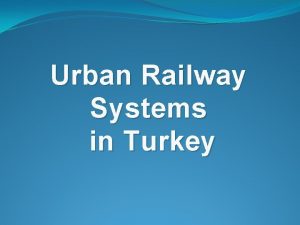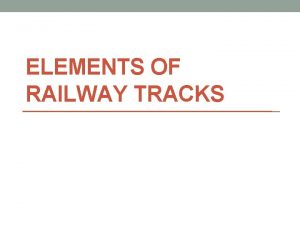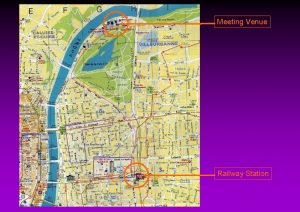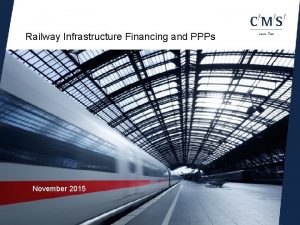Composite Railway Crossties Status Developments Markku Vilkki Conenor

















- Slides: 17

Composite Railway Crossties Status & Developments Markku Vilkki, Conenor Ltd

Composite Railway Crossties (known also as ”Sleepers”) v OVER THE PAST 20 YEARS COMPOSITE SLEEPERS MADE FROM RECYCLED PLASTICS HAVE BECOME COMMON STANDARD PRODUCTS v SEVERAL MANUFACTURERS ALL OVER THE WORLD INTHE USA, RUSSIA, CANADA, JAPAN, UK, GERMANY, INDIA, TAIWAN, AFRICA, THAILAND, NETHERLANDS AND AUSTRALIA v COMPOSITE RAILWAY SLEEPERS ARE REPLACING EXISTING CONCRETE, STEEL AND, PARTICULARLY, TIMBER ONES IN BOTH MAINLINE AND HEAVY HAUL RAIL NETWORKS references from one US manufacturer Axion

Benefits of Composite Sleepers v ENGINEERING - MEET AND EXCEED NATIONAL STANDARDS v MORE DURABLE - RESISTANT TO ROT, FUNGUS, INSECTS, AND MOISTURE v EASY-TO-INSTALL - INSTALLS USING TRADITIONAL WOOD-TIE EQUIPMENT v ENVIRONMENTALLY SAFER & CLEANER - INERT MATERIAL AND CONTAINS NO TOXIC MATERIALS v GREEN SUSTAINABLE PRODUCT - MADE FROM 100% RECYCLED MATERIAL AND ARE 100% RECYCLABLE AT THE END OF THEIR LONGLIFE v PROVEN LONGER LASTING - RESIST PLATE WEAR, HOLD SPIKES, AND MAINTAIN GAUGE ACCUMULATING WELL AXLE LOADS v LOWER LIFE CYCLE COSTS

Manufacturers of Sleepers Composite v HTTP: //WWW. AXIONSI. COM/ v HTTP: //WWW. ATLASTIES. COM/INDEX. PHP v HTTP: //WWW. BOISCOMMERCIALWOOD. COM/CATCONTENT. AS P? CAT 2 ID=24 v HTTP: //INTEGRICO. COM/PRODUCTS/INTEGRITIES/ v HTTP: //WWW. TIETEK. NET/PRODUCT. ASP v HTTP: //WWW. SICUT. CO. UK/ v HTTP: //WWW. ICSSERVICES. COM. AU/WKG/PDFS/CARBONLOC MANUALGENERAL 5. PDF v HTTP: //TVEMA. COM/CATALOG/SUPPORT-SYSTEMS. HTML

Manufacturing Process of Composite Sleepers MANUGACTURING OF COMPOSITE SLEEPERS IN THREE STEPS; 1. PROCESSING PROPER PLASTIC WASTE 2. PRODUCTION OF COMPOSITE MATERIAL FORMULATION WITH OR WITHOUT REINFORCEMENTS 3. PRODUCTION OF SLEEPERS - by intrusion method - by extrusion method

Manufacturing Process of Composite Sleepers VIDEO IN YOUTUBE FROM INTEGRICO HTTPS: //WWW. YOUTUBE. COM/WATCH? V=8 T ZNUV-0 WLS

Different Types of Composite Sleepers v TYPE-1 SLEEPERS WITH SHORT OR NO FIBRE REINFORCEMENTS SLEEPERS THAT CONSIST OF RECYCLED PLASTIC (PLASTIC BAGS, SCRAPPED VEHICLE TYRES, PLASTIC COFFEE CUPS, MILK JUGS, LAUNDRY DETERGENT BOTTLES ETC. ) OR BITUMEN WITH FILLERS (SAND, GRAVEL, RECYCLED GLASS OR SHORT GLASS FIBRES < 20 MM) v TYPE-2 SLEEPERS WITH LONG FIBRE REINFORCEMENT IN THE LONGITUDINAL DIRECTION TYPE-2 SLEEPERS ARE SLEEPER TECHNOLOGIES REINFORCED WITH LONG CONTINUOUS GLASS FIBREREINFORCEMENT IN THE LONGITUDINAL DIRECTION AND NO OR VERY SHORT RANDOM FIBRE IN THE TRANSVERSE DIRECTION v TYPE-3 SLEEPERS WITH FIBRE REINFORCEMENT IN LONGITUDINAL AND TRANSVERSE DIRECTIONS TYPE-3 SLEEPERS HAVE LONG REINFORCEMENT FIBRES IN BOTH LONGITUDINAL AND TRANSVERSE DIRECTIONSAND CONSEQUENTLY BOTH THE FLEXURAL AND SHEAR BEHAVIOUR ARE DOMINATED BY FIBRES.

Different Types of Composite Sleepers Source: Composite Railway Sleepers – Recent developments, challenges and future prospects / Article in Composite Structures · August 2015

Comparing Advantages and Disadvantages of Composite Type 1 and Type 2 Sleepers Source: Composite Railway Sleepers – Recent developments, challenges and future prospects / Article in Composite Structures · August 2015

Summary of Composite Type 1 Sleepers v The most common composite sleeper material, Type-1 sleepers offer a range of benefits including ease of drill and cut, good durability, consumption of waste materials, reasonable price, and tough. v However, it suffers from low strength and stiffness, limited design flexibility, temperature and creep sensitivity, and low resistance to fire. v The notable sleepers in this category are Tie. Tek (USA), Axion (USA), Integri. Co (USA), I-Plas (UK), Tufflex (S-Africa), Natural rubber (Thailand), Kunststof Lankhorst Product KLP (Netherlands), Mixed Plastic Waste MPW (Germany) and Woodcore (USA). Source: Composite Railway Sleepers – Recent developments, challenges and future prospects / Article in Composite Structures · August 2015

How to Improve Strength of Composite Type 1 Sleepers v Because of the short length of the fillers, they do not have a major reinforcing effect and the failure behavior of these sleepers is mainly polymer driven. v Due to the lack of any long reinforcement fibres these sleepers are flexible and expand contract significantly with temperature. However, as stronger Type 2 and Type 3 composite sleepers become very expensive up to 10 x more compared to wood sleepers, there is an incentive to develop further the low cost Type 1 sleepers to become stronger and more durable !

Comparing the Performance of Composite Sleepers to AREMA (USA) Specification Requirements Source: Composite Railway Sleepers – Recent developments, challenges and future prospects / Article in Composite Structures · August 2015

MOR- and MOE-values of Composite Type 1 Sleepers v Modulus of Rupture (flexural strength) and Modulus of Elasticity (stiffness) values for composite materials are defined in 3 -point bending test in laboratory conditions v The minimum values stated in AREMA (USA) specification (MOR @13. 8 MPa and MOE @1. 2 GPa) represent those levels typical for polyethylene (PE) polymer – and this is logical because Type 1 composite sleepers are made mainly from this waste material When producing the composite material formulation one may combine other stronger waste materials in the PE-waste polymer for improving the mechanical performance of Type 1 sleepers into much higher level without increasing costs !!

Choice of Materials for Type 1 Composite Sleepers

MOR- and MOE-values of Conenor Developed FRP-Waste Reinforced HDPE-Waste Plastic MOR-values up to 36 MPa ! MOE-values up to 3 GPa ! Mechanical properties of ”FRC”material from waste exceed AREMA requirements by 2, 5 times and outperform those existing Type 1 composite sleepers in the market Ideal for stronger Type 1 Composite Sleepers !

FRP-Waste Reinforced Material is an Invention by Conenor Ltd Patent Application EP 3 159 127 A 2 v Simple and Low Cost Thermo-Mechanical Process v Using Commodity Existing Equipment v No Processing Waste v Applicable Stronger Material for Plastic Processing (injection, extrusion, intrusion) v Technology Available on License Basis v see http: //www. conenor. com/recyclingthermoset-frpwaste/

Conenor Ltd – a Private Development Company in Waste Composites v SME founded 1995 v Inventor of unique CONEX®-Extrusion Technology v Participation in EU-Commission funded R&D-projects; - http: //www. ircow. eu/ - https: //osirysproject. eu/ - http: //www. hiserproject. eu/ - http: //cordis. europa. eu/project/rcn/210181_en. html - v Outsourced client R&D-projects from waste composites for major corporations (including among others); - UPM; see http: //www. conenor. com/client-projects-trials/ - Stora. Enso - Kuusakoski / Metsähallitus v Composite extrusion facilities for R&D, sampling and pilot production at Orimattila Town in South-Finland - www. conenor. com
